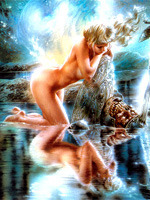Faeries as a Lost Race
 Faerie lore is ubiquitous; nearly every culture throughout human history and around the globe, including Amerindian and African tribes, have some form of Faerie tradition. Some people who believe in the existence of Faeries have used this as evidence supporting their claim: if Faeries are not real, why is their lore so widespread? Creationists often use the same argument for a global flood: if it never occurred, why do so many cultures have a flood myth?
Faerie lore is ubiquitous; nearly every culture throughout human history and around the globe, including Amerindian and African tribes, have some form of Faerie tradition. Some people who believe in the existence of Faeries have used this as evidence supporting their claim: if Faeries are not real, why is their lore so widespread? Creationists often use the same argument for a global flood: if it never occurred, why do so many cultures have a flood myth?Unfortunately, there is a serious flaw in this argument, and it can be demonstrated quite easily. Most cultures have some form of Cinderella and Puss-in-Boots folktale; are we to assume they also are based in fact? The point is, the ubiquitous nature of certain myths, legends, and folktales is not evidence that they have a factual basis, but rather it is evidence that they speak to a powerful idea in the human collective unconscious.
But if Faeries are not real, why is their lore so common? What could be the source that triggered the development of folk traditions about them? There are a fair number of theories explaining the origin of Faerie lore, but I think the most intriguing is what we could call the lost race theory. It assumes that before modern humans moved into an area, it was occupied by a more primitive race, usually tribes of hunter-gatherers. The modern humans were farmers, and when they came in they displaced the hunter-gatherers by taking their hunting grounds and turning them into farms. The old race retreated into the wilderness on the fringe of civilization, into areas the farmers could not go: dense, old-growth forests; marshes and bogs; wasteland; the seashore; and hilly or mountainous regions. There they continued to live hidden from the new race, which soon forgot who and what they originally were.
At first, the old race would avoid the new race, except for capturing or killing people who trespassed into their territory. After a number of generations, however, the old race would begin to trickle back into their former range. They would begin by observing the new race, and sometimes people would encounter them by accident, perhaps even capture them on occasion. After awhile they would begin stealing things from the new race: food, such as grain and animals; tools and implements; ornaments; even weapons. Eventually, they would start to kidnap people as well: babies and children mostly, to replenish their dwindling numbers, but also girls and young, unmarried women to be mates, or nursing mothers to provide milk for their own babies. Young men might also be taken, to serve as slaves, or craftsmen, or even lovers.
The thing that needs to be kept in mind is that this old race is not some form of bestial, sub-human species, but is fully human like the new race, just as bright, articulate, and innovative, but with a lower-level technology. They would be quick to see the advantage of the food, tools, and crafts of the new race, they would comprehend that their blood (i.e., genetic material) was compatible with that of the new race, and they could become enamored with comely members of the new race, particularly if inbreeding had reduced the physical attractiveness of their own people. However, their morality as hunter-gatherers would prompt them to take what they wanted rather than try to trade for it.
In time, though, some of the old race might start interacting with members of the new race, particularly those who lived away from the main group. They could begin by borrowing food and items they want, giving items of their own in return, including things they might value for being pretty but which the new race valued as money, like precious stones, raw gems, and trinkets of gold and silver. That might lead to the old race helping the new race slaughter animals and collect the harvest, or perform chores around the farm and in the house, in exchange for food. This could lead to them becoming semi-permanent residents, but they would still be suspicious of the new race and so refuse to wear clothes given to them, so as to maintain their independence. Men of the new race might even take women of the old race as wives, either for an advantage, because they could not attract new race wives, or because they found old race girls attractive. However, each would have to live by the woman's standards of correct behavior or religious taboos, which would undoubtedly conflict with his own and could lead to her leaving him if he offended her in some way.
Over time, the old race would gradually creep into the new race's folklore, as mysterious beings with magical powers who could influence nature, give good or bad fortune, pass unseen, and steal whatever they wished. Long after the old race had either died out or been assimilated into the new race, the stories would continue, eventually becoming Faerie lore.
Published on August 13, 2013 04:52
•
Tags:
faeries, hunter-gatherers, lost-race, medb-herenn
No comments have been added yet.
Songs of the Seanchaí
Musings on my stories, the background of my stories, writing, and the world in general.
- Kevin L. O'Brien's profile
- 23 followers



